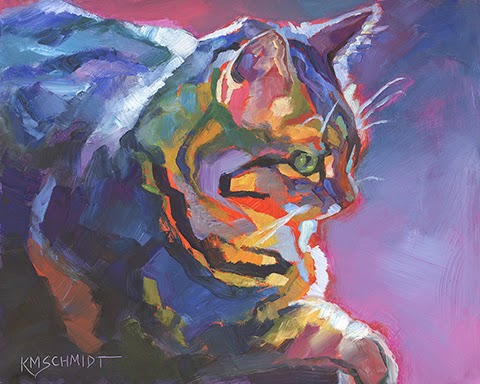The mountains are calling
and I must go.
JOHN MUIR (1838-1914)
SOLD
Road Trippin’ © 2015 Karen Mathison Schmidt
12 x 16 x ¾ inches • oil on ¾" cradled Ampersand Museum Series GessobordTM
private collection • Chicago, Illinois
Warmer weather gets me thinking about road trips, like this one a couple of summers ago to a family reunion in Colorado. This is just as we were crossing the border from New Mexico into Colorado. Love that glorious, crisp summer light!
The palette I used for this one is the same as in Monday’s post, and here my work-in-progress photos:
1. On my reference photo (which I work from on my computer screen) I put grid lines to help me block in my subject in just the right position on my board.
2. The rough-in, using French ultramarine thinned with Gamsol. Along the sides you can see where I made little marks with my brush to indicate where the imaginary grid lines should be, and little cross marks in the middle to indicate where the lines would cross each other. Notice how I made perspective lines along the top and bottom of the fence posts; this is an easy way to get the height of each post just right.
3. Now I start filling the different masses with their underlying colors. In my photo I see that the sky and the road are the lightest areas, then the mountains, then the grass. The car and the trees are the darkest areas. I keep all this in mind while filling in my colors. (One thing to keep in mind is that in almost every landscape, your sky -- and any ground water reflecting the sky -- is going to be the lightest area in your painting.)
In this stage I want to keep all the colors transparent, so I’m thinning with Gamsol for a watercolor effect. The way I do this is just dip the brush in my little container of thinner, then just barely in my paint, and wash it onto my board. Sometimes for large areas I’ll brush a good bit on and then spread it around lightly with a paper towel or clean paint rag. To get a darker color, like the ultramarine I use on those dark trees, I use just a little more paint. It doesn’t take much!
The sky and the farthest mountain in my photo have warm pink undertones, so I choose brilliant pink for those, and mixing in a little white for the sky because it’s a little lighter than the mountain. The white will tend to make my pink opaque, but thinning keeps it a transparent lighter pink.
You can see in the reference photo that the road is really four main strips of color. The far left (oncoming) lane is lightest, and sort of pinkish, the tire-worn areas of the right lane are a little darker, and purplish, and the center of the lane and the shoulder of the road are a little lighter, but not as light as that far left lane. I could have used pink instead of green there, but I wanted to make those a slightly cooler temperature than that far left lane.
The mountains have three main areas getting lighter as the ridges recede into the distance. The middle one has slight green undertones, I used Caribbean blue and turquoise there, and permanent mauve for that closest, most purple mountain.
Since I’ve been practicing working with a true impressionistic palette, I have been leaving off the black, so for the fence posts and those power poles, I make a tiny mixture of diox mauve, Caribbean blue, and a little orange and red to make a rich dark brown. French ultramarine and diox mauve for the trees, and last but not least, yummy Cadmium red medium as the underpainting for the grassy areas, to make them really shimmery with summer light.
NOW, I stop to have my lunch and let this stage dry for about half an hour. It won’t be completely dry, but mostly.
4. Now I paint in the sky, using thick paint but loose strokes to let a little of that pink show through. Most of the time the sky will be lighter at the bottom and get gradually deeper color as you go up. Notice this next time you’re outside where you can see the whole sky.
Next I paint in the mountains. For all these areas I put on some generous strokes of white and then brush in my colors, mixing right on the painting instead of on my palette.
5. For darker areas, like the trees, I put on the pure pigment first (in this case, viridian green) and then add the highlights with a little permanent green and yellow, brushing it right into that luscious dark green on the painting.
After this I work on painting the road. This to me is the most interesting part of the whole painting. I spent a good hour painting this part. Notice how I just left a block of blue where the car will be.
6. Last, I paint in the car and the field on the right, adding some highlights along the horizon of the grass on both sides of the road.
Since I’ve used thick paint for the grass in the lower right, I can just use the handle of my paint brush to scratch my signature over there.
Oh, and I made the car red, just because. Artist’s prerogative.

















































